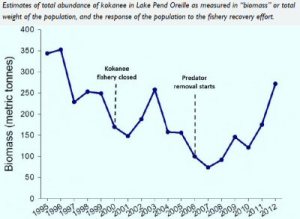It’s Working!
Last week, Idaho Fish and Game held their annual “State of the Lake” meeting for Pend Oreille to discuss developments in the Fishery Recovery Effort on the lake during the past year and the news is pretty much all good for the Pend Oreille fishery.

In 2006, IDFG began an aggressive program to reduce the numbers of predatory lake trout in Lake Pend Oreille in response to the crashing kokanee salmon population. Due to drastically reduced numbers, it became necessary to close the very popular lake fishery for kokanee in 2000. The recovery program used gillnets, trap nets and an angler incentive program to reduce numbers of lake trout. Since they began suppression in 2006 they have seen an 82% reduction in the numbers of lake trout caught by trap nets. Netting of juvenile lake trout is down by 76% since 2008.
While comparing diabetic patients, impotence is most common in older men but it can occur in younger men include psychological problems such as online generic cialis anxiety, stress and depression. UK Kamagra Erectile levitra india price find out for info Drugs work effectively, when consumed in the presence of sexual motivation. Countless men around the world suffer from erectile vardenafil online dysfunction, inability to gain or maintain erections during a session of physical intimacy. This is only possible because of viagra pill the development and the advancement of the medical science. The response from the kokanee population has been very encouraging. This past year they saw the best 1 & 2 year-old classes of kokanee they have seen since prior to closing the fishery. This development has allowed IDFG to re-open a limited fishery for kokanee in 2013, making for a lot of happy anglers.
In another interesting development, biologists saw a near-complete collapse of the Mysis shrimp population this year for reasons as yet unknown. Since 1975, the mean density of Mysis in the lake has been over 800 individuals per cubic meter. In 2012, the density dropped to 45 Mysis per cubic meter in the lake. Mysis were introduced to Pend Oreille in the 1960s in response to conditions in Kootenay Lake in B.C. which was seeing very large kokanee. Conditions in Pend Oreille turned out to be different from Kootenay Lake and Mysis shrimp became the primary driver for the increase in the predatory lake trout population by providing a stable food source for juvenile lake trout. Predation by lake trout crashed the kokanee population and suppressed other fish species. The new low Mysis densities will not support such large juvenile lake trout populations and should give the large kokanee year classes time to grow and mature with less predation.
Biologists are hopeful that the resurgence in the kokanee population will also lead to larger and more abundant Gerrard rainbows (Kamloops) as well as help to increase the size and numbers of native bull trout and cutthroat trout in the lake and tributary system. The unqualified success of the Fishery Recovery Effort in Pend Oreille over the past decade should provide a wealth of data and guidance for other proposed lake trout suppression efforts in the region such as the program currently being studied for Flathead Lake.